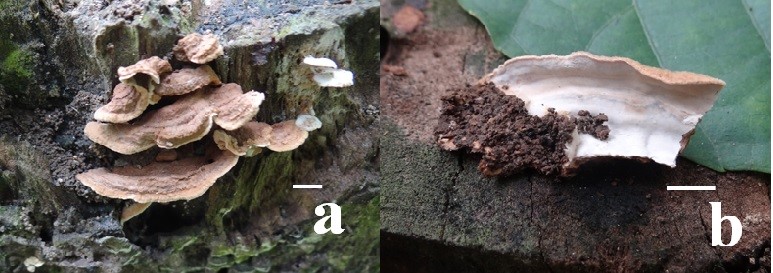Laxitextum subrubrum R. Saha, A.K. Dutta & K. Acharya, sp. nov.
MycoBank number: MB 559644; Index Fungorum number: IF 559644; Facesoffungi number: FoF 11347; (Fungal Diversity Notes, 2023)
Description
Basidiocarp pileate, imbricate, sessile, soft-spongy when fresh and brittle on drying, 10 ̶ 30 mm long, 5 ̶ 20 mm wide and up to 1 ̶ 2 mm thick. Pileus upper surface uneven, slightly zonate, glabrous, dull red (9C4). Margin thin, wavy, brownish orange (7C3). Hymenophore smooth, white (1A1), cracked on drying. Context soft, thin, dull red (9C3).
Hyphal system monomitic, generative hyphae 2.9 ̶ 5.9 µm wide, hyaline, thin to thick walled, clamped. Oleiferous hyphae 3.5 ̶ 6.5 µm wide. Gloeocystidia 102 ̶ 156 × 8.5 ̶ 15 µm in diam. lanceolate, sometimes apex moliniform, pale orange (5A3), filled with oily substance. Basidia 23.5 ̶ 38 × 5.5 ̶ 9 µm in diam. narrowly clavate, hylanie, thin walled, 4-sterigmate, with basal clamp. Basidiospores 3.5 ̶ 4.74 ̶ 5.9 × 2.9 ̶ 3.06 ̶ 3.5 µm in diam., Q= 1.2 ̶ 2, Qm= 1.54, thin walled, hyaline, ellipsoid, apiculate, finely echinulate, strongly amyloid in melzers reagent.Asexual state: not observed.
Material examined: INDIA, West Bengal, Jalpaiguri District, Moraghat range, khuttimari, 26.4728°N, 88.5957°E, elevation 144 m, on dead wooden logs of unknown angiosperm, 7 October 2018, R. Saha & K. Acharya (CUH AM774, holotype).
Distribution: INDIA, West Bengal, Jalpaiguri District, Moraghat range, khuttimari,

Fig. 1 Field pictures of the basidiocarp. a-d Laxitextum subrubrum (CUH AM774, holotype). Scale bars: a-d = 5 mm.

Fig. 4 Laxitextum subrubrum (CUH AM774, holotype). a Basidia. b gloeocystidia. c oleiferous hyphae. e generative hyphae. f basidiospores. Scale bars: a–f = 5 μm.
